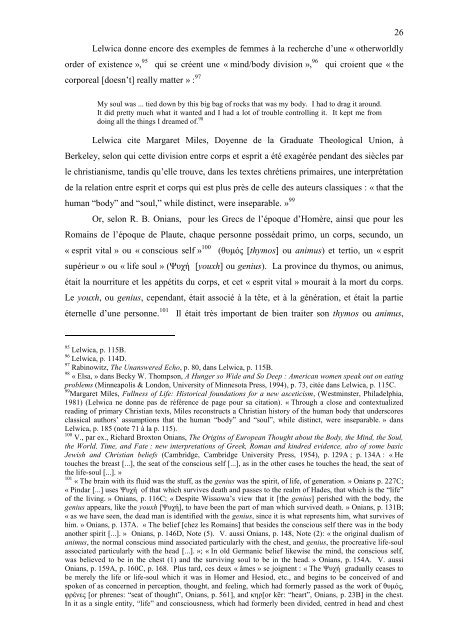S'ANEANTIR OU S'EPANOUIR : - ResearchSpace@Auckland - The ...
S'ANEANTIR OU S'EPANOUIR : - ResearchSpace@Auckland - The ...
S'ANEANTIR OU S'EPANOUIR : - ResearchSpace@Auckland - The ...
You also want an ePaper? Increase the reach of your titles
YUMPU automatically turns print PDFs into web optimized ePapers that Google loves.
Lelwica donne encore des exemples de femmes à la recherche d’une « otherworldly<br />
order of existence », 95 qui se créent une « mind/body division », 96 qui croient que « the<br />
corporeal [doesn’t] really matter » : 97<br />
My soul was ... tied down by this big bag of rocks that was my body. I had to drag it around.<br />
It did pretty much what it wanted and I had a lot of trouble controlling it. It kept me from<br />
doing all the things I dreamed of. 98<br />
Lelwica cite Margaret Miles, Doyenne de la Graduate <strong>The</strong>ological Union, à<br />
Berkeley, selon qui cette division entre corps et esprit a été exagérée pendant des siècles par<br />
le christianisme, tandis qu’elle trouve, dans les textes chrétiens primaires, une interprétation<br />
de la relation entre esprit et corps qui est plus près de celle des auteurs classiques : « that the<br />
human “body” and “soul,” while distinct, were inseparable. » 99<br />
Or, selon R. B. Onians, pour les Grecs de l’époque d’Homère, ainsi que pour les<br />
Romains de l’époque de Plaute, chaque personne possédait primo, un corps, secundo, un<br />
« esprit vital » ou « conscious self » 100 (θσμός [thymos] ou animus) et tertio, un « esprit<br />
supérieur » ou « life soul » (Ψστή [youxh] ou genius). La province du thymos, ou animus,<br />
était la nourriture et les appétits du corps, et cet « esprit vital » mourait à la mort du corps.<br />
Le youxh, ou genius, cependant, était associé à la tête, et à la génération, et était la partie<br />
éternelle d’une personne. 101 Il était très important de bien traiter son thymos ou animus,<br />
95 Lelwica, p. 115B.<br />
96 Lelwica, p. 114D.<br />
97 Rabinowitz, <strong>The</strong> Unanswered Echo, p. 80, dans Lelwica, p. 115B.<br />
98 « Elsa, » dans Becky W. Thompson, A Hunger so Wide and So Deep : American women speak out on eating<br />
problems (Minneapolis & London, University of Minnesota Press, 1994), p. 73, citée dans Lelwica, p. 115C.<br />
99 Margaret Miles, Fullness of Life: Historical foundations for a new asceticism, (Westminster, Philadelphia,<br />
1981) (Lelwica ne donne pas de référence de page pour sa citation). « Through a close and contextualized<br />
reading of primary Christian texts, Miles reconstructs a Christian history of the human body that underscores<br />
classical authors’ assumptions that the human “body” and “soul”, while distinct, were inseparable. » dans<br />
Lelwica, p. 185 (note 71 à la p. 115).<br />
100 V., par ex., Richard Broxton Onians, <strong>The</strong> Origins of European Thought about the Body, the Mind, the Soul,<br />
the World, Time, and Fate : new interpretations of Greek, Roman and kindred evidence, also of some basic<br />
Jewish and Christian beliefs (Cambridge, Cambridge University Press, 1954), p. 129A ; p. 134A : « He<br />
touches the breast [...], the seat of the conscious self [...], as in the other cases he touches the head, the seat of<br />
the life-soul [...]. »<br />
101 « <strong>The</strong> brain with its fluid was the stuff, as the genius was the spirit, of life, of generation. » Onians p. 227C;<br />
« Pindar [...] uses Ψστή of that which survives death and passes to the realm of Hades, that which is the “life”<br />
of the living. » Onians, p. 116C; « Despite Wissowa’s view that it [the genius] perished with the body, the<br />
genius appears, like the youxh [Ψστή], to have been the part of man which survived death. » Onians, p. 131B;<br />
« as we have seen, the dead man is identified with the genius, since it is what represents him, what survives of<br />
him. » Onians, p. 137A. « <strong>The</strong> belief [chez les Romains] that besides the conscious self there was in the body<br />
another spirit [...]. » Onians, p. 146D, Note (5). V. aussi Onians, p. 148, Note (2): « the original dualism of<br />
animus, the normal conscious mind associated particularly with the chest, and genius, the procreative life-soul<br />
associated particularly with the head [...]. »; « In old Germanic belief likewise the mind, the conscious self,<br />
was believed to be in the chest (1) and the surviving soul to be in the head. » Onians, p. 154A. V. aussi<br />
Onians, p. 159A, p. 160C, p. 168. Plus tard, ces deux « âmes » se joignent : « <strong>The</strong> Ψστή gradually ceases to<br />
be merely the life or life-soul which it was in Homer and Hesiod, etc., and begins to be conceived of and<br />
spoken of as concerned in perception, thought, and feeling, which had formerly passed as the work of θσμός,<br />
φρένες [or phrenes: “seat of thought”, Onians, p. 561], and κηρ[or kēr: “heart”, Onians, p. 23B] in the chest.<br />
In it as a single entity, “life” and consciousness, which had formerly been divided, centred in head and chest<br />
26














